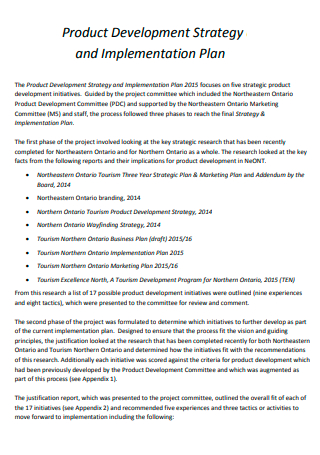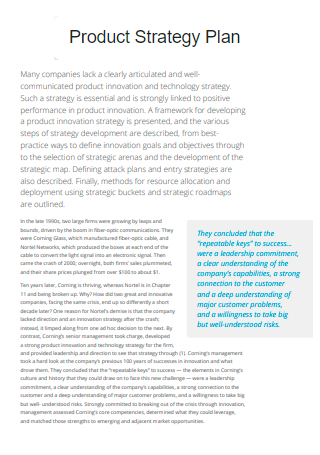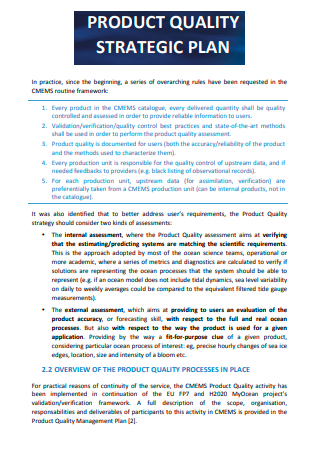3+ Sample Product Strategy Plan
FREE Product Strategy Plan s to Download
3+ Sample Product Strategy Plan
Product Strategy Plan: What IS It About?
Types of Product Strategies
How To Create a Product Strategy Plan
FAQs
What are the other types of product strategies?
What are some of the benefits of having a product strategy plan?
What are some of the types of pricing strategies?
Product Strategy Plan: What IS It About?
Think of Netflix’s “to deliver fast, easy entertainment in a friendly, straightforward way.” Think of Google’s “provides access to the world’s information in one click.” That’s what a product strategy plan is all about. It’s about the strategic planning of how you want the product to be positioned in the market to achieve the business’s goals. It answers the questions of “What do we do?” and “How do we do it?”. A product strategy plan is just like a roadmap that guides you on how to best maximize the product to serve and implement the company’s goals. Strategic planning starts from product conceptualization up to product distribution. That’s why creating a thorough and effective strategic plan is important to ensure the product’s success in the market.
Types of Product Strategies
Product strategies are created depending on how the product is planned to be launched in the market. It takes into consideration the target audience, the current market conditions, as well as the existing competitors. Product strategies are grouped according to competition priorities, advantages, and business strategies. It is all about the people, the process, and the technology or resources used. Product strategizing is handled by the marketing team and handed over to the sales team. It is teamwork that is set on accomplishing the business’s mission and vision. Aside from serving as a roadmap, it is a motivating factor that inspires people to come together to fulfill the business’s goals. Here are the types of product strategies that are commonly used by the marketing team.
How To Create a Product Strategy Plan
A product strategy plan is created, focusing on how a business wants the product to be established in the market. It involves identifying the goals or objectives and carefully planning the methods on how to achieve those goals. Having good strategic planning helps set priorities and focus, appropriately utilizing and maximizing the tools, equipment, and resources provided by the business for those identified goals. There are no hard and fast rules when it comes to creating and formatting a product strategy plan. What you need to keep in mind is that for a product strategy plan to be effective, it needs to contain the essential elements that make up an effective strategic plan.
-
Executive Summary
The executive summary of a product strategy plan is an overview of the whole strategic process. It gives a brief introduction and background of the business or the product, and it also provides detail on why there is a need for the product. Oftentimes, an executive summary also contains the mission and vision statement of the business. A mission statement describes the purpose and the motivation behind the product’s conception. It also reflects the business’s culture and values. A vision statement gives a depiction of what the business wants to achieve with its product conception within a given time. It can be in the form of the monetary return of revenue, commercial growth, or as simple as establishing the product within the market through brand awareness and recognition.
-
Market Analysis
To do an effective product strategy plan, you first need to have a better understanding of the market you’re trying to get into. Market analysis is about determining the market’s condition if it’s ready or not for the product to be launched, or vice versa, such as if the product is ready for the current market. One way of doing market analysis is classifying your target market consumer according to demographics. They’re grouped according to their age, gender, income, lifestyle, location, political classification, et cetera. Another way of doing market analysis is through the SWOT analysis method. SWOT stands for Strengths, Weaknesses, Opportunities, and Threats of and to the product. A product’s strength is its concept uniqueness, which makes it stand out from its competition. It is that value proposition that consumers are willing to pay for despite any asking price. Weaknesses are those factors that prevent a product from being fully optimized in the market. Some examples of a product’s weakness are lack of budget or funding for research and development, lack of funding for supplies production, lack of manpower or field sales personnel, lack of tools and equipment, and so on. Opportunities are those aspects that the product can utilize to fully maximize its position and presence in the market. By today’s standards, these opportunities usually come in the form of distribution channels, such as online digital channels like websites, social media or social networking platforms, blogs and vlogs, and so on. Threats are those factors that could potentially harm or put at risk the product’s position in the market, such as increase of competitor’s presence, increase in local tax, increase cost of logistics and/or fuel for transportation, extreme weather conditions, et cetera.
-
Strategies and Tactics
The strategies and tactics are the action plans developed based on the company’s objectives, mission, and vision. These are the identified, specific steps to achieve the company’s goals when it comes to establishing the product. This is where the marketing team and the sales team work hand in hand in conceptualizing activities. The marketing team handles the marketing plan, while the sales team does the sales planning. Often used interchangeably, there is a distinctive difference between a marketing plan and a sales plan. A marketing plan uses the market analysis method, identifying who are the target market consumers and what appeals to that market. It’s all about identifying what are the best ways to reach that target market. A sales plan is all about selling the product, focusing more on achieving the targeted revenue. Creating a sales plan should be based on the SMART goals concept, meaning, plans that should be Specific, Measurable, Achievable, Relevant, and Time-bound. With all of these planning incorporated together, some of the strategies and tactics that could be done are, for instance, utilizing the social media and social networking platforms to broaden customer reach; using influencers or celebrities to promote the product; increasing the presence of field sales personnel; increasing product presence through retail or distributorship; utilizing traditional media platforms for advertising such as radio and TV broadcast, or even billboard or community announcements; promotions, sponsorships, product event launches; and/or added-value goods and services when purchasing the products. When strategizing and creating the tactics, it is important to adhere to a timeline, in essence creating that sense of urgency that everyone should work together, be focused, and be consistent, to achieve the goals set forth.
-
Monitoring and Evaluating
Monitoring and evaluating is a good way of measuring if the strategies and tactics are working or not. It is good to have a tracker that monitors the product’s progress in the market regularly. It can be done weekly, monthly, semi-annually, or even annually, depending on the overall business’s goals. Evaluating is the reviewing and revising of the action steps. Aside from getting the sales revenue, one way of reviewing is getting consumers’ feedback. Your consumers’ thoughts and opinions should always be considered since they’re the ones on which a product’s lifespan or life cycle depended. Today’s online digital or social media platforms are a good source of getting customers’ feedback. Revising would depend upon the product’s success. If a product is doing well, then there will be no need in revising any action steps. But if a product is unable to catch up with the targeted revenue goals or is underperforming, then there will be a need to do a revision or an overhaul towards the identified action steps.
FAQs
What are the other types of product strategies?
Market segmentation is also one of the product strategies that is being utilized. It is the process of classifying the market according to types of customers, or demographics. A business that utilizes this kind of strategy often will come up with a product concept that meets the needs of the different types of customers. A service strategy is utilized wherein a business focuses on the after-sales, customer service aspects of the product. Another is the flexibility strategy. Businesses create their business plan according to how the market changes, adapting to the changing times.
What are some of the benefits of having a product strategy plan?
One of the benefits of having a product strategy is being able to understand the market’s condition. Another benefit is that the product strategy plan is a good way to measure and monitor a product’s success in the market. It also helps to open up the product to brand awareness and recognition, increasing its scope of converting potential customers into actual buying consumers.
What are some of the types of pricing strategies?
A pricing strategy is a method of how you put a value on your product depending on factors such as cost supply production, resources, and market environment or your target market. Some of the pricing strategies utilized are penetration pricing, wherein the product is introduced at a low price to gain market share; price skimming, where your pricing is based on how high the market accepts your price, and then gradually lowering them over time; and/or economy pricing, where a product is launched at a low price, cheaper than the competitions’ products. The return of revenue for the economy pricing strategy is gained through volume production and distribution.
Netflix, McDonald’s, Google, and all these other giant companies gained momentum from successful product strategy planning. They were able to position their products well in the market, the consumers loved their products, and obviously, they were able to convey the message that the value proposition of their product and company is trying to relate. This is proven in the statistics of their consistently increasing number of consumers and subscribers, year in year out.
Creating a product strategy plan shouldn’t be a daunting task. With the help of our easy-to-fill-out and ready for download strategy planning templates, you’ll be on your way to creating that effective product strategy plan that will move your business towards the top of its success! Check out our product strategy plan templates now!




